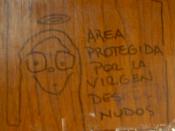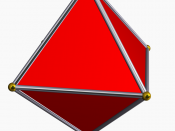SA/V Ratio Significant? Hypothesis: The surface area to volume ratio determines the rate of undiffused volume.
Materials: -3 cubes of 3% agar-phenolphthalein 250ml beaker (1cm, 2cm &3cm on each side) spoon Millimeter ruler razor blade 100 ml of 4% sodium hydroxide solution (NaOH) Procedure: 1. Take the 3 agar blocks provided in the materials, and using the razor blade, cut one block to 1cm3, another to 2cm3, and the final block to 3cm3.
2. Create a chart and label after the model shown below: Size of Side Surface Area Volume SA/V Ratio Distance Diffused Undiffused Surface Area 1cm 2cm 3cm 4cm .5cm **The items Underlined and Italicized are not actual blocks you will cut, the numbers shown for these will be estimates.
**The headings of the columns should be Bold.
3. Place the 3 agar cubes into the beaker and pour the sodium hydroxide until the blocks are submerged.
Very gently turn the cubes frequently.
4. After 10 minutes, remove the blocks with the spoon and place on a paper towel; blot dry. Write down any observations, and consider the following: Is there any evidence that indicates that sodium hydroxide diffuses into an agar block? What about evidence of diffusing out of the agar? 5. Use a razor blade to slice each piece in half. Be sure to dry the razor thoroughly before cutting the next block to ensure precise results. Measure the depth and width of the colored area in centimeters. Determine the surface area of the central uncolored part of each block in square centimeters and the volume in cubic centimeters. (Note: (Do NOT round the decimal places).
6. Useful formulas: Length of Cubic Side Surface Area of a cube = length x width x height Ratio of Surface area to volume = Surface area...


